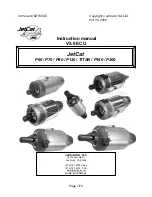
6.
Fuel Oil System
6.1
Acceptable fuel characteristics
The fuel specifications are based on the ISO 8217:2012 (E) standard. Observe that a few
additional properties not included in the standard are listed in the tables. For maximum fuel
temperature before the engine, see chapter "Technical Data".
The fuel shall not contain any added substances or chemical waste, which jeopardizes the
safety of installations or adversely affects the performance of the engines or is harmful to
personnel or contributes overall to air pollution.
6.1.1
Marine Diesel Fuel (MDF)
Distillate fuel grades are ISO-F-DMX, DMA, DMZ, DMB. These fuel grades are referred to as
MDF (Marine Diesel Fuel).
The distillate grades mentioned above can be described as follows:
●
DMX: A fuel which is suitable for use at ambient temperatures down to -15°C without
heating the fuel. Especially in merchant marine applications its use is restricted to lifeboat
engines and certain emergency equipment due to the reduced flash point. The low flash
point which is not meeting the SOLAS requirement can also prevent the use in other marine
applications, unless the fuel system is built according to special requirements. Also the
low viscosity (min. 1.4 cSt) can prevent the use in engines unless the fuel can be cooled
down enough to meet the min. injection viscosity limit of the engine.
●
DMA: A high quality distillate, generally designated as MGO (Marine Gas Oil).
●
DMZ: A high quality distillate, generally designated as MGO (Marine Gas Oil). An alternative
fuel grade for engines requiring a higher fuel viscosity than specified for DMA grade fuel.
●
DMB: A general purpose fuel which may contain trace amounts of residual fuel and is
intended for engines not specifically designed to burn residual fuels. It is generally
designated as MDO (Marine Diesel Oil).
Table 6-1
MDF specifications
Test method ref.
ISO-F-DMB
ISO-F-DMZ
ISO-F-DMA
Unit
Property
2.0
2.0
2.0
cSt
Viscosity, before injection pumps, min.
1)
24
24
24
cSt
Viscosity, before injection pumps, max.
1)
2
3
2
cSt
Viscosity at 40°C, min.
ISO 3104
11
6
6
cSt
Viscosity at 40°C, max.
ISO 3675 or 12185
900
890
890
kg/m³
Density at 15°C, max.
ISO 4264
35
40
40
Cetane index, min.
ISO 8574 or 14596
2
1.5
1.5
% mass
Sulphur, max.
ISO 2719
60
60
60
°C
Flash point, min.
IP 570
2
2
2
mg/kg
Hydrogen sulfide. max.
2)
ASTM D664
0.5
0.5
0.5
mg KOH/g
Acid number, max.
ISO 10307-1
0.1
3)
—
—
% mass
Total sediment by hot filtration, max.
ISO 12205
25
4)
25
25
g/m
3
Oxidation stability, max.
ISO 10370
—
0.30
0.30
% mass
Carbon residue: micro method on the 10% volume
distillation residue max.
ISO 10370
0.30
—
—
% mass
Carbon residue: micro method, max.
ISO 3016
0
-6
-6
°C
Pour point (upper) , winter quality, max.
5)
Wärtsilä 31 Product Guide - a1 - 18 October 2016
6-1
6. Fuel Oil System
Wärtsilä 31 Product Guide
Содержание 31
Страница 1: ...PRODUCT GUIDE W rtsil 31...
Страница 6: ...This page intentionally left blank...
Страница 10: ...This page intentionally left blank...
Страница 30: ...This page intentionally left blank...
Страница 36: ...This page intentionally left blank...
Страница 44: ...This page intentionally left blank...
Страница 88: ...This page intentionally left blank...
Страница 116: ...This page intentionally left blank...
Страница 134: ...This page intentionally left blank...
Страница 138: ...14 4 W rtsil 31 Product Guide a1 18 October 2016 W rtsil 31 Product Guide 14 Foundation...
Страница 140: ...14 6 W rtsil 31 Product Guide a1 18 October 2016 W rtsil 31 Product Guide 14 Foundation...
Страница 148: ...This page intentionally left blank...
Страница 150: ...This page intentionally left blank...
Страница 154: ...This page intentionally left blank...
Страница 160: ...This page intentionally left blank...
Страница 162: ...This page intentionally left blank...
Страница 165: ......
Страница 166: ......
Страница 167: ......
















































